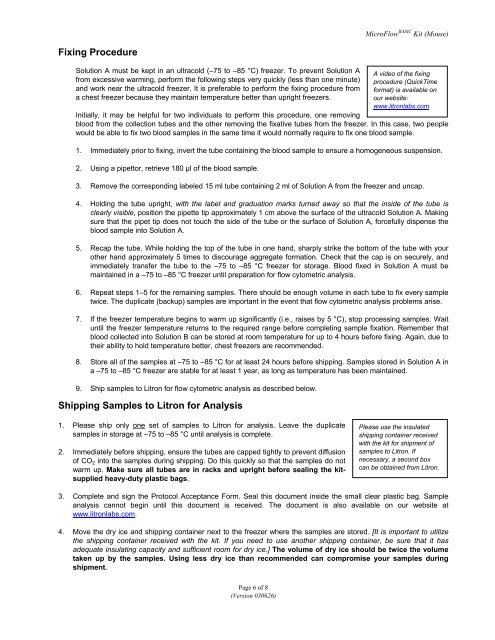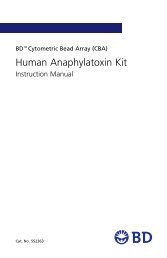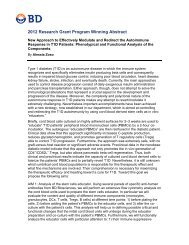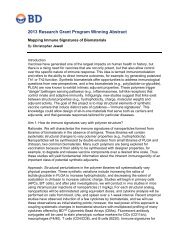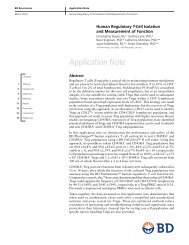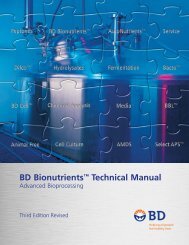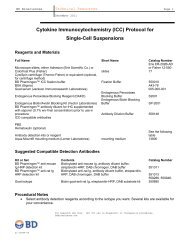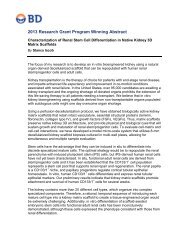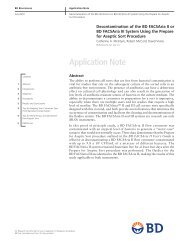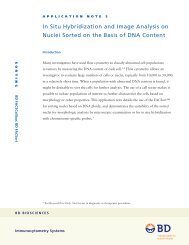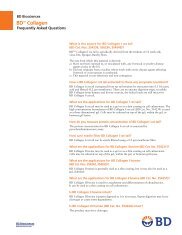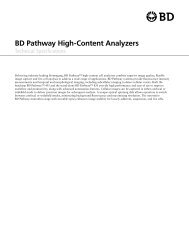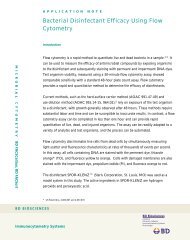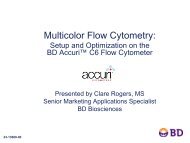TDS - BD Biosciences
TDS - BD Biosciences
TDS - BD Biosciences
Create successful ePaper yourself
Turn your PDF publications into a flip-book with our unique Google optimized e-Paper software.
Fixing Procedure<br />
Solution A must be kept in an ultracold (–75 to –85 °C) freezer. To prevent Solution A<br />
from excessive warming, perform the following steps very quickly (less than one minute)<br />
and work near the ultracold freezer. It is preferable to perform the fixing procedure from<br />
a chest freezer because they maintain temperature better than upright freezers.<br />
Page 6 of 8<br />
(Version 030626)<br />
MicroFlow BASIC Kit (Mouse)<br />
Initially, it may be helpful for two individuals to perform this procedure, one removing<br />
blood from the collection tubes and the other removing the fixative tubes from the freezer. In this case, two people<br />
would be able to fix two blood samples in the same time it would normally require to fix one blood sample.<br />
1. Immediately prior to fixing, invert the tube containing the blood sample to ensure a homogeneous suspension.<br />
2. Using a pipettor, retrieve 180 µl of the blood sample.<br />
3. Remove the corresponding labeled 15 ml tube containing 2 ml of Solution A from the freezer and uncap.<br />
4. Holding the tube upright, with the label and graduation marks turned away so that the inside of the tube is<br />
clearly visible, position the pipette tip approximately 1 cm above the surface of the ultracold Solution A. Making<br />
sure that the pipet tip does not touch the side of the tube or the surface of Solution A, forcefully dispense the<br />
blood sample into Solution A.<br />
5. Recap the tube. While holding the top of the tube in one hand, sharply strike the bottom of the tube with your<br />
other hand approximately 5 times to discourage aggregate formation. Check that the cap is on securely, and<br />
immediately transfer the tube to the –75 to –85 °C freezer for storage. Blood fixed in Solution A must be<br />
maintained in a –75 to –85 °C freezer until preparation for flow cytometric analysis.<br />
6. Repeat steps 1–5 for the remaining samples. There should be enough volume in each tube to fix every sample<br />
twice. The duplicate (backup) samples are important in the event that flow cytometric analysis problems arise.<br />
7. If the freezer temperature begins to warm up significantly (i.e., raises by 5 °C), stop processing samples. Wait<br />
until the freezer temperature returns to the required range before completing sample fixation. Remember that<br />
blood collected into Solution B can be stored at room temperature for up to 4 hours before fixing. Again, due to<br />
their ability to hold temperature better, chest freezers are recommended.<br />
8. Store all of the samples at –75 to –85 °C for at least 24 hours before shipping. Samples stored in Solution A in<br />
a –75 to –85 °C freezer are stable for at least 1 year, as long as temperature has been maintained.<br />
9. Ship samples to Litron for flow cytometric analysis as described below.<br />
Shipping Samples to Litron for Analysis<br />
1. Please ship only one set of samples to Litron for analysis. Leave the duplicate<br />
samples in storage at –75 to –85 °C until analysis is complete.<br />
2. Immediately before shipping, ensure the tubes are capped tightly to prevent diffusion<br />
of CO 2 into the samples during shipping. Do this quickly so that the samples do not<br />
warm up. Make sure all tubes are in racks and upright before sealing the kitsupplied<br />
heavy-duty plastic bags.<br />
A video of the fixing<br />
procedure (QuickTime<br />
format) is available on<br />
our website:<br />
www.litronlabs.com.<br />
Please use the insulated<br />
shipping container received<br />
with the kit for shipment of<br />
samples to Litron. If<br />
necessary, a second box<br />
can be obtained from Litron.<br />
3. Complete and sign the Protocol Acceptance Form. Seal this document inside the small clear plastic bag. Sample<br />
analysis cannot begin until this document is received. The document is also available on our website at<br />
www.litronlabs.com.<br />
4. Move the dry ice and shipping container next to the freezer where the samples are stored. [It is important to utilize<br />
the shipping container received with the kit. If you need to use another shipping container, be sure that it has<br />
adequate insulating capacity and sufficient room for dry ice.] The volume of dry ice should be twice the volume<br />
taken up by the samples. Using less dry ice than recommended can compromise your samples during<br />
shipment.


